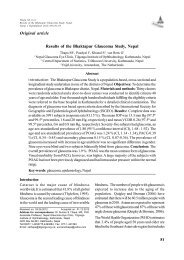nepjoph 2012.pmd - Nepalese Journal of Ophthalmology
nepjoph 2012.pmd - Nepalese Journal of Ophthalmology
nepjoph 2012.pmd - Nepalese Journal of Ophthalmology
You also want an ePaper? Increase the reach of your titles
YUMPU automatically turns print PDFs into web optimized ePapers that Google loves.
Sitaula (Kharel) R et al<br />
Idiopathic retinal vasculitis in Nepal<br />
Nepal J Ophthalmol 2012; 4(8):256-262<br />
Retinal laser photocoagulation therapy was the<br />
modality <strong>of</strong> treatment in 22 eyes (21.56%). Six<br />
eyes (5.88%) underwent pars plana vitrectomy for<br />
vitreous haemorrhage. Though the Mantoux test was<br />
positive in 18 cases (35.3%), tuberculosis was<br />
confirmed with X-ray chest and sputum examination<br />
for acid fast bacilli in only 1 individual (1.96%) who<br />
was commenced on anti-tubercular therapy.<br />
Thirty-four (66.7%) patients had history <strong>of</strong> treatment<br />
for retinal vasculitis for the past episode or for a<br />
recent attack before visiting our centre. Only<br />
17(33.3%) cases were new.<br />
Twenty eyes (19.6%) gained one or more lines on<br />
Snellen’s distant visual acuity chart, 7 eyes (6.86%)<br />
lost one or more lines and 4 eyes (3.92%) had no<br />
perception <strong>of</strong> light. However, 71 eyes (69.60%)<br />
maintained their initial visual acuity through the<br />
available follow-up period.<br />
The above results were compared with the results<br />
<strong>of</strong> the study conducted a decade ago among the<br />
patients in the same clinic (Table-2).<br />
Table 2<br />
Comparison <strong>of</strong> the present study with the similar study <strong>of</strong> 10 years ago<br />
Parameters Study <strong>of</strong> 1998-2000 Study <strong>of</strong> 2009-2011 Remarks<br />
No. <strong>of</strong> patients 57 51<br />
Male/Female ratio 19:1 2.64:1 p= 0.0027<br />
Age group affected<br />
31 – 40 years<br />
(54.43%)<br />
21 – 30 years (43.13%)<br />
Laterality <strong>of</strong> involvement Bilateral (56.14%)<br />
Unilateral (43.86%)<br />
Presenting visual acuity Normal : 48.24%<br />
Blindness: 27.19%<br />
Final visual acuity Normal: 50.27%<br />
Blindness: 22.80%<br />
Stage <strong>of</strong> presentation Stage III: 40.44%<br />
Stage I: 28.08%<br />
Stage IV: 20.22%<br />
Stage II : 11.23%<br />
Association with pulmonary<br />
tuberculosis<br />
Bilateral (35.3%);<br />
Unilateral (64.7%)<br />
Normal: 69.6%<br />
Blindness: 17.64%<br />
Normal: 71.8%<br />
Blindness:12.64%<br />
Stage IV: 41.17%<br />
Stage III: 13.72%<br />
Stage II: 9.8%<br />
Stage I: 5.88%<br />
2 cases (3.5%) 1 case (1.96%)<br />
Mean IOP 13.54± 1.875mmHg 14.10 ± 2.375mmHg<br />
p= 0.0044<br />
Discussion<br />
Eales’ disease, observed more commonly in the<br />
Indian subcontinent than in the rest <strong>of</strong> the world,<br />
occurs in young healthy adult males, initially<br />
presenting as retinal periphlebitis and later as retinal<br />
ischemia that may lead to vascular alterations and<br />
neovascularization (reference required).<br />
In the previous study from this centre, bilateral<br />
involvement was found in 56.14%. In the present<br />
study, unilateral (64.7%) presentation was more<br />
than bilateral (35.3%), which is statistically significant<br />
(p = 0.0044). This disparity could be due to an<br />
increased awareness among the symptomatic<br />
patients to seek care at a tertiary centre. It could<br />
also be due to the duration <strong>of</strong> the study. Clustering<br />
<strong>of</strong> cases in second to fourth decade <strong>of</strong> life is similar<br />
to the reports from India. Kumar et al (year <strong>of</strong><br />
259




